The Royal Netherlands Navy is the naval force of the Kingdom of the Netherlands. It is one of the four Netherlands Armed Forces. It was founded on 8 January 1488, making it the third-oldest naval force in the world.
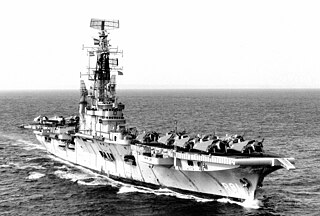
HNLMS Karel Doorman (R81) was a Colossus-class aircraft carrier of the Royal Netherlands Navy. Formerly the British ship HMS Venerable, she was sold to the Netherlands in 1948 as a light attack carrier. In 1960, she was involved in the decolonization conflict in Western New Guinea with Indonesia. In the mid 1960s, her role was changed to anti-submarine warfare carrier and only ASW aircraft and helicopters were carried. An engine room fire took her out of service in 1968. She was sold to Argentina in 1969 and renamed ARA Veinticinco de Mayo.

The Karel Doorman-class frigates are a series of eight multi-purpose vessels built for the Royal Netherlands Navy. Its namesake is Karel Doorman, a Dutch naval officer whose ship was struck by a Japanese torpedo in the battle of the Java Sea in 1942, and who, as a result of which, went down with his ship.
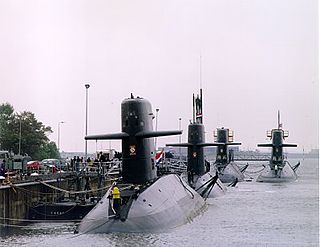
The Walrus-class submarine is the only submarine class currently in operation in the Royal Netherlands Navy. The boats have been in service since 1990 and are all named after sea mammals.

The four De Zeven Provinciën-class frigates are air-defence and command frigates in service with the Royal Netherlands Navy. This class of ships is also known as "LCF". The ships are similar to the German Sachsen-class frigates in role and mission.
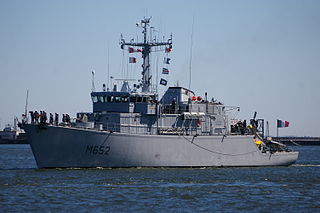
The Tripartite class is a class of minehunters developed from an agreement between the navies of Belgium, France and the Netherlands. A total of 35 ships were constructed for the three navies. The class was constructed in the 1980s–1990s in all three countries, using a mix of minehunting, electrical and propulsion systems from the three member nations. In France, where they are known as the Éridan class they are primarily used as minehunters, but have been used for minesweeping and ammunition transport in Belgium and the Netherlands, where the Tripartites are known as the Alkmaar class.

The Holland-class ocean-going patrol vessels are a class of four ocean-going patrol vessels constructed for the Royal Netherlands Navy. They are designed to fulfill patrol and intervention tasks against lightly armed opponents, such as pirates and smugglers, but have much higher level electronic and radar surveillance capabilities which are used for military stabilization and security roles, short of outright war. Without sonar or long range weapons, they utilize the surveillance capabilities of the Thales integrated mast, which integrates communication systems and two four-faced phased arrays for air and surface search.

HNLMS Karel Doorman is a multi-function support ship for amphibious operations of the Royal Netherlands Navy, which is also used by the German Navy. The ship replaced both of the navy's replenishment oilers: HNLMS Zuiderkruis and HNLMS Amsterdam. At 204.7 m she is the largest ship in service with the Royal Netherlands Navy.

HNLMS Rotterdam is the lead ship in the Rotterdam-class landing platform dock of the Royal Netherlands Navy. The ship is named after the Dutch city of Rotterdam.

Louise-Marie (F931) is a Karel Doorman-class frigate of the Marine Component of the Belgian Armed Forces that was commissioned in 2008. It is the second of the two frigates of this class that were purchased from the Royal Netherlands Navy on 22 December 2005. It was originally commissioned in 1991 in the Netherlands, where it served as HNLMS Willem van der Zaan (F829).
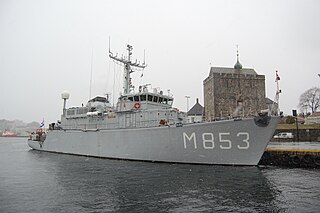
The Alkmaar class is a ship class of fifteen minehunters that were built in the Netherlands for the Royal Netherlands Navy. They are based on the design of the Tripartite class, which was developed by a collaborative effort between the Netherlands, Belgium and France, and replaced the minesweepers and minehunters of the Dokkum class.
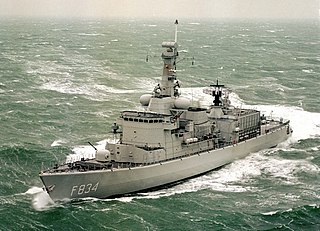
HNLMS Van Galen (F834) is a ship of the Karel Doorman class of multi-purpose frigates of the Royal Netherlands Navy. Built by the shipyard Koninklijke Schelde Groep in Vlissingen. The ship is named after captain and convoy commander Johan van Galen and served from 1994 to 2008 with the Dutch navy. The radio call sign of the frigate was "PAMG". In 2009 HNLMS Van Galen was sold Portugal. The ship was transferred in 2010 to the Portuguese Navy, where the ship was put into service as the NRP Dom Francisco de Almeida (F334).

The Roofdier class was a class of six frigates that were built in the United States as Patrol Craft Escorts (PCE) for the Netherlands. The frigates were loaned to the Royal Netherlands Navy as part of the Mutual Defense Assistance Act (MDAP) and from 1954 to 1984 served as the Roofdier-class frigates.

HNLMS Tromp (F801) was a frigate of the Tromp class. The ship was in service with the Royal Netherlands Navy from 1975 to 1999. The frigate was named after Dutch naval hero Tromp. The ship's radio call sign was "PADE".

Konarak is a Hendijan-class support vessel of the Iranian Navy. It was built in the Netherlands and has been in service since 1988. Originally intended as a support and logistics ship, Konarak was overhauled in 2018, and was armed with anti-ship missiles. The vessel was struck by a missile fired from the Iranian frigate Jamaran in a friendly fire incident during training on 10 May 2020, killing 19 sailors.

F126 or Niedersachsen-class frigate is a planned German frigate class intended to replace the F123 Brandenburg-class frigates in the German Navy. The ships are to be the largest surface warships to join the German Navy since World War II. The first ship, Niedersachsen, is planned to be commissioned in 2028, with Saarland, Bremen, and Thüringen to follow. On 8 April 2024, Germany exercised their option and purchased an additional two frigates.
In April 2018, the Dutch Government approved a multi-year investment program for the Dutch Navy and allocated funds for the 2018–2030 period. The Dutch Defence Materiel Administration (DMO) is in charge of the procurement of these new ships.

HNLMS Den Helder is a new replenishment oiler under construction for the Royal Netherlands Navy. Also known as the Combat Support Ship (CSS), Den Helder is planned to fill the gap of replenishment at sea that was left after HNLMS Amsterdam was sold to Peru in 2014.

The Netherlands and Belgium are doing a joint procurement for the replacements of the Tripartite-class/Alkmaar-class minehunters. Each of the two countries is procuring six new mine countermeasure (MCM) vessels, which makes for a total of 12 MCM ships. The new MCM ships, developed by Naval Group, will include a range of unmanned systems including unmanned surface, aerial and underwater vehicles alongside towed sonars and mine identification and neutralization ROVs.

The Orka-class submarine is a future submarine class currently planned for the Royal Netherlands Navy. The submarines will replace the aging Walrus class.


















